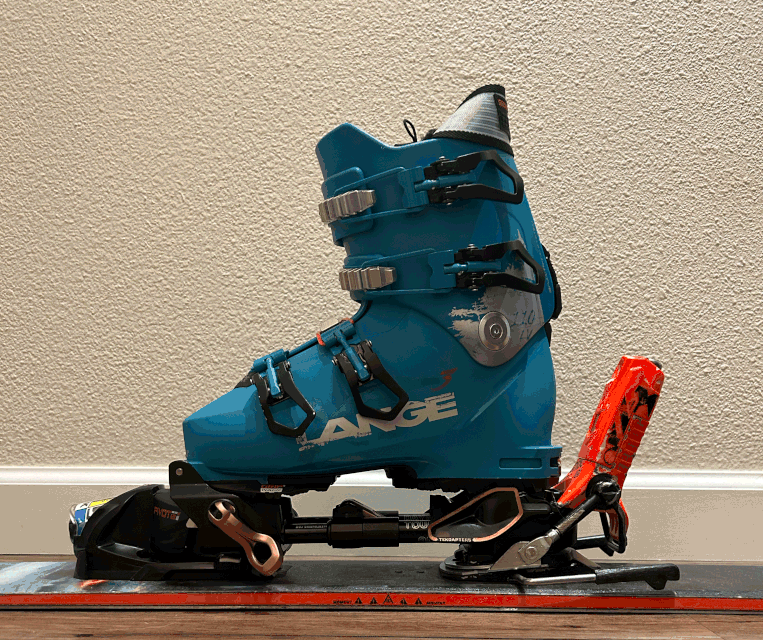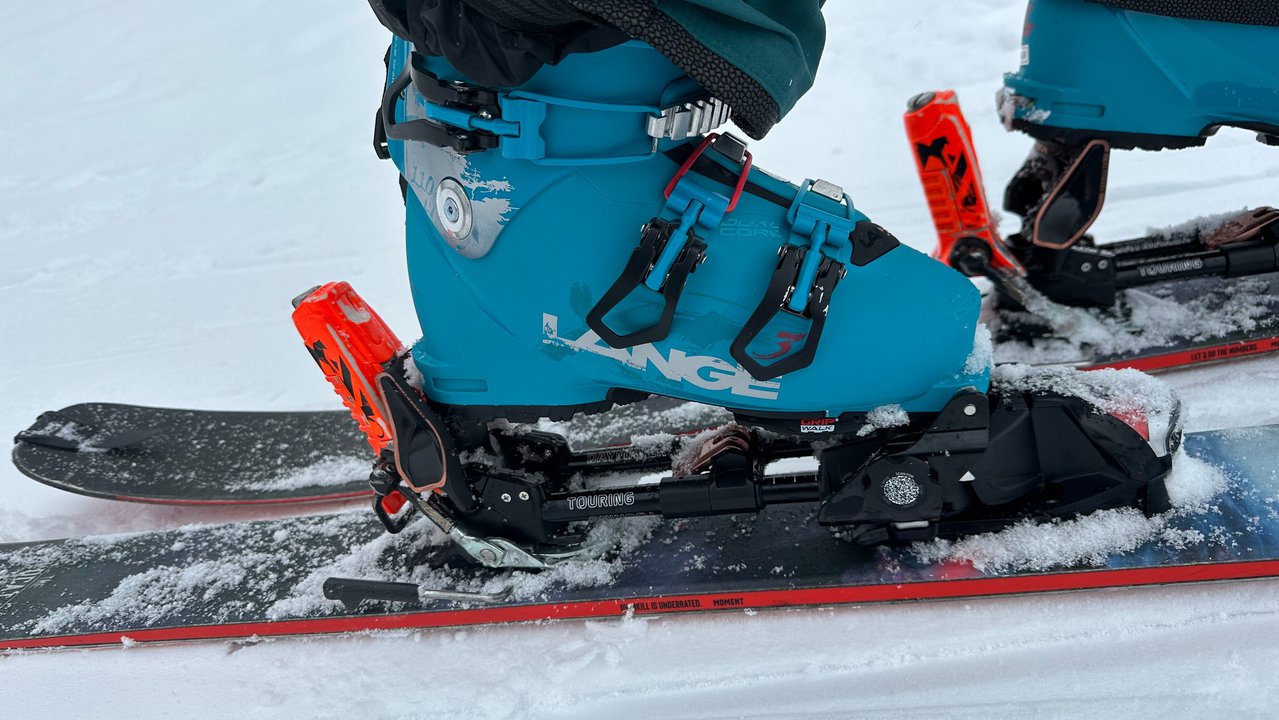Daymaker Touring TEKDAPTERS — First Look Review
Measured weight: 1048g (Pair)
MSRP: $279.99
The Original Daymaker Classic has been on the market for more than 7 years now, offering a creative solution for skiers looking to try out touring on their existing setup. Now the newest touring solution from Daymaker, the TEKDAPTERS, is here.
The TEKDAPTERS system is for users with pin-compatible boots, allowing them to utilize pin-efficiency on the uphill, with the safety & performance of alpine bindings on the ski down.
If you’re not already familiar with Daymaker Touring—the brainchild of Chris Trunek and Giray Dadali—they make binding adapters that click directly into alpine bindings (such as a Look Pivot, Salmon STH, Marker Griffon, Tyrolia Attack, etc.), then attach to your boots and allow free heel for touring.
Despite the slow start to winter across the West Coast, I was able to take the new TEKDAPTERS for a tour on Teton Pass in Jackson, Wyoming earlier this month. While I haven’t had the opportunity to try out the Original Daymakers, they’ve been reviewed by the team here at Newschoolers, which can be read here.
A bit of background on my perspective, I got my start touring on a Salomon Guardian frame binding almost 10 years ago, and then later switched to a Dynafit Radical, which I’ve been on for the last ~6 years. I also tour occasionally on the CAST system, and will compare the two later in this review.
_
Adapter Setup
Setting up the TEKDAPTERS for the first time took no longer than 10 minutes. There is a quick video tutorial that walks you through the setup, which demonstrates the different components of the binding, how to fit it to your alpine binding, setting up the tech toe, and fitting the tech toe to your boot.
Like any new pin setup, It may take a few tries to get used to getting your pins into the adapters, because the motion is definitely different from tech bindings you may have seen or tried before. But once you get it and close the latch, you’re definitely locked in and won’t have to worry about slipping out on your walk.
The adapters also have three riser levels, all of which I was able to switch between with my poles. (Note: they are burlier risers, so it took a few tries to get the hang of switching between levels with my poles. Just make sure you're using the tab on the grips, not your flimsy baskets).

The three riser levels
Also worth mentioning, is the sturdy dry-sack that comes with the adapters, which allows you to store them away in your pack for the ski down, without getting your gear wet. After initial setup, your adapters should be good to go for future tours and require minimal-to-no adjustments each time you go out.
_
First Impressions, The Uphill Experience
After touring exclusively on tech bindings, I’ll admit that I was a bit skeptical of how these would feel. My main hesitations came from the weight (this is a given with a setup like this, and unavoidable, but worth noting), and the stack height, or lift off of the ski that your boot will rest when in relation to the top of the ski.
Despite my skepticism, I was immediately impressed by how smooth and solid these adapters walked as I took my first strides. The walking motion was much more similar to the smoothness of pin setups that I’ve been on than that of a frame binding. While the setup is heavier than a pin setup, the pins allow a heel to be completely free of any frame or extra weight, which keeps your boot lift light and easy.
This makes the additional weight less noticeable as it acts like a heavier ski rather than a heavier boot where you feel the lift with each step. Whereas on a Frame Binding like the Salmon Guardian (with a weight of 2920g per pair on the 13 din model), you’re not only lifting your boot, but you’re also lifting the weight of your binding with each stride, rather than having the weight of your binding glide below you as it does with the TEKDAPTERS. On the topic of weight, it’s worth noting that this setup pairs great with a “hybrid” ski, or one that's around 1,500g-2,000g per ski (ie. The Line Vision). A heavier downhill ski that is ~2500g+ per ski is going to be heavy to tour on no matter what binding you choose.
The lift, or stack height also didn’t appear extremely noticeable on the short tour I went on. I tried a couple of off-track sidehills and felt really stable in the control of my skis. New for this adapter is the ‘Field Goal Guide Rail System’ on each level of the risers, which are designed to keep your boot in place as you step down, keeping it from moving side-to-side on more technical terrain (see GIF above to see how boot is resting between the sides).
I can see the stack height being a potential issue on a more technical tour with steep, icy kick turns by having less stability than a binding. I know this has been a criticism of the Daymaker Classic, and while these have significant upgrades and will undoubtedly be sturdier, it’s worth noting.
Below I get into a couple of more in-depth comparisons to the TEKDAPTERS’ closest competitors. I don’t talk about true tech bindings here as the pros/cons are pretty straightforward. Those other bindings are lightweight and going to walk better in most cases as that’s exactly what they’re built for. The TEKDAPTERS comes with a more affordable cost to entry, unmatched flexibility between skis, solid touring capabilities, and most importantly, the ability to ride your alpine binding on the way down with no modifications.
_
TEKDAPTERSvs. Salomon Guardian 13 Frame Binding
I touched on this above in the Uphill experience, but the TEKDAPTERS are definitely an upgrade over the Salmon Guardian or any frame binding for that matter. The TEKDAPTERS give a smoother uphill experience, with no additional weight with each heel lift, three riser levels, and allow you to ride a true alpine binding on the downhill.
The Guardian can be solid as an alpine option, but when I had them on my primary setup my first winter out west in 2016, I noticed side-to-side wiggle/play over time, and the additional stack height above the ski 100% of the time is less than ideal.
While using the Daymakers TEKDAPTERS system in-lieu of a frame binding does require that your boots have tech fittings in the toes, these fittings are becoming more and more common with most of the freeride boots on the market these days and if you don’t have tech fittings, you can look at the Daymakers Classic.
_
TEKDAPTERS vs. CAST System
The CAST System ($349.95 MSRP + Pivot 15 or 18s) is in my opinion the closest in comparison to the new TEKDAPTERS. Both require tech fittings but provide different uphill experiences.
The TEKDAPTERS system can be used with whatever alpine binding you have, and can easily be switched throughout your quiver if you have multiple skis you’d like to utilize it for, whereas CAST is restricted to just one ski.
CAST gives a smoother uphill experience with the tech-toe being lighter, and closer to that of a pin setup (minus the pivot parts & alpine ski you’re on), making it ideal for longer tours. I have found that the tech toe can be a bit finicky, and you are required to switch it out with your pivot heel, which can freeze up on longer days. They’ve definitely made improvements on this throughout the years, but it’s worth noting.
The TEKDAPTERS, on the other hand, is more useful for switching between bindings and is a cheaper upfront investment. They both walk solid but provide different user experiences depending on your end goal.
_
TEKDAPTERS vs. Salomon Shift
When the Shift first came out, they prided themselves on being a touring binding that skis like an alpine binding in-bounds, but the common consensus is that’s not the case for most. The pro of the Shift is that it does tour well, but getting ‘Shifted’ (tomahawking after releasing unexpectedly from a Shift Binding) is the norm on the downhill. I have seen that the Shifts work fine for smaller individuals who ride at a lower din or less aggressively, but it’s safe to say they’re not a substitute for an alpine binding for many.
The TEKDAPTERSon the other hand, will be heavier on the uphill, but you’ll have the full stability and reliability of your alpine binding on the descent.
_
Conclusion (Who this is for)
Like I said earlier, I’m really impressed with how well the Daymaker TEKDAPTERS performed. They’re built well, provide a lot of flexibility, and seem to be even more solid than their predecessor. At $279.99 USD, they provide the most affordable entry to reliable touring for those with tech fittings in their boot.
If you’re just getting into touring, tour resorts outside of normal operating hours, or are looking for an option that allows you to get out into the side-country or backcountry where you rely on having a solid alpine binding for hitting booters, big hits, or charging down the mountain, I can’t recommend these enough.
They’re also a great option for anyone who wants to tour on different skis in their quiver, without investing in multiple pairs of touring bindings (just remember— you’ll need skins that fit each ski). The TEKDAPTERS can save you from re-mounting every season if you’re switching skis and are a great addition if you’re looking to have more than one setup in your touring quiver.
The TEKDAPTERS are not for you if you’re touring more than 2,500 ft vertical on average, like long walks in the woods, and are looking to go lightweight to save weight on the uphill.
Overall, I’m really impressed with these and will be recommending them to others for general touring use. I will even see myself keeping these around to utilize more of my quiver for shuttle laps on Teton Pass and sled skiing.


Comments